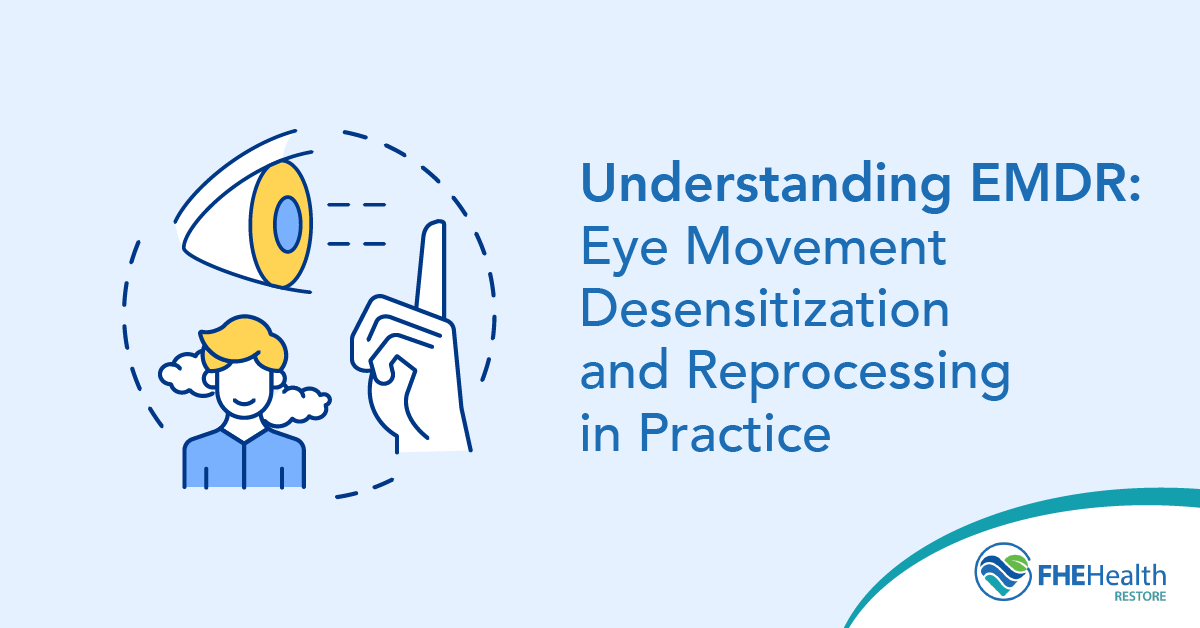Post-traumatic stress disorder is a common condition. An estimated 6.8% of Americans will experience PTSD at some point in their lives. Many treatment options are available for people who are struggling to process past trauma. One treatment that’s becoming increasingly popular to help people with PTSD is eye movement desensitization and reprocessing therapy. But what is EMDR therapy, and how safe and effective is it?
In this article, we explore the practice of EMDR, how it works, the potential dangers of EMDR and how it can benefit some individuals.
What Is EMDR Therapy, and How Does It Work?
EMDR is a mental health treatment technique that was first trialed in 1989. It’s thought to be helpful for people with a variety of mental health challenges, but it’s most commonly used to help manage PTSD.
The Eight Phases of EMDR Treatment
EMDR therapy follows an eight-stage process that begins with taking a history of the patient and planning the treatment so the therapist can work out how best to help the patient reprocess trauma. The eight phases of EMDR treatment are:
- History taking and treatment planning. The therapist asks questions to learn about the individual’s trauma so they can understand how to approach the treatment.
- Preparation. The therapist sets terms and expectations, explains the process and makes sure the patient understands what the treatment involves and is ready to process difficult emotions.
- Assessment. The patient identifies the target event they’d like to reprocess and sets baselines describing how thinking about the event makes them feel. Those metrics are used to determine the therapy’s efficacy.
- Desensitization. During this phase, the patient focuses on the traumatic event and uses eye movements, sounds or taps to reduce their discomfort.
- Installation. In this phase, the individual works to associate the traumatic memory with a positive belief or thought, repeating the thought patterns until those beliefs feel true.
- Body scan. After completing phases 4 and 5, the patient is asked to hold the target event in their mind while scanning their body for signs of stress or disturbance and attempting to reprocess those negative thoughts until they’re fully removed from their body.
- Closure. The therapist works with the patient to bring them back to a state of calm in the present moment. In early sessions, patients may not fully achieve the desired goal in phases 4 to 6. Regardless, the therapist helps them leave the session feeling calm and grounded.
- Reevaluation. After reprocessing, the therapist discusses how the session went. If multiple sessions are planned, future sessions begin by confirming that the patient still feels little distress and has strong positive cognition when thinking about the target event.
It may take a few EMDR sessions to fully reprocess negative thoughts. However, many individuals with PTSD find EMDR achieves lasting results after fewer sessions than other forms of talking therapy.
How Bilateral Stimulation Supports Trauma Processing
EMDR uses bilateral eye movement as a key component of its treatment process. Researchers believe bilateral eye movement selectively disrupts the perceptual representation of traumatic memories. In doing so, it weakens the emotional response.
Once their distressing memories are less powerful, people can begin to forge new associations with that memory. For example, the traumatic memory may gradually become associated with the calmness of the therapy session. Over time, recollection of the traumatic event becomes less emotionally charged until the patient no longer feels triggered when reminded of the trauma.
What Conditions EMDR Is Used to Treat
EMDR is primarily used to treat PTSD. However, it can be used to help with other conditions, including:
- Anxiety disorders
- Phobias
- Depression
- Addiction
- Eating disorders
- Performance anxiety
Since the treatment requires evoking negative emotions or memories so they can be reprocessed, some form of negative feeling or thought pattern is required for the treatment to be effective.
What to Expect During an EMDR Session
EMDR sessions can be intense. To reprocess a difficult memory or trauma, you have to think about it. The therapist tries to get you to feel the kind of distress you normally experience when triggered. Reliving traumatic experiences can be distressing, but a qualified EMDR therapist supports you throughout the experience.
Before the session, your therapist gives you some advice on tools and coping techniques to help you stay grounded if the negative emotions become too much for you. They also ask you questions about your triggers and the negative experiences you’ve had.
You must communicate with your therapist throughout the process. If you aren’t feeling strong emotions while you’re working through the desensitization phase, the therapy is unlikely to be successful. If this is the case, let your therapist know so they can find new ways to access the traumatic memories.
Therapists use a variety of techniques during the desensitization period, including having you tap either side of your body, make eye movements from side to side or listen to sounds that switch from one headphone to the other. Each of these forms of sensory input achieves the same goal of stimulating different sides of your brain in quick succession, helping you process the thoughts and emotions you’ve unlocked.
Once you’ve desensitized yourself to the memory, you focus on associating it with something positive. This can take time and requires trust in your therapist. It also requires a willingness to be reflective and provide clear feedback on your thoughts and emotions. At the end of the session, the therapist ensures you feel safe and calm and reviews the session.
Some people experience heightened anxiety or persistent feelings of distress after EMDR, but these usually pass quite quickly. However, this therapy can be dangerous for those who have schizophrenia or other preexisting mental health conditions. EMDR may also bring forward false memories in some individuals. Because of this risk, it’s vital to work with a properly qualified and experienced therapist.
Finding a Qualified EMDR Therapist
Processing past trauma requires working with a therapist you can trust who’s had extensive EMDR training. At Restore Mental Health, we have a team of therapists who have experience in a variety of treatments, including EMDR. To learn more about our PTSD treatment options or find out if EMDR is suitable for your mental health challenges, contact us now for a confidential consultation.



